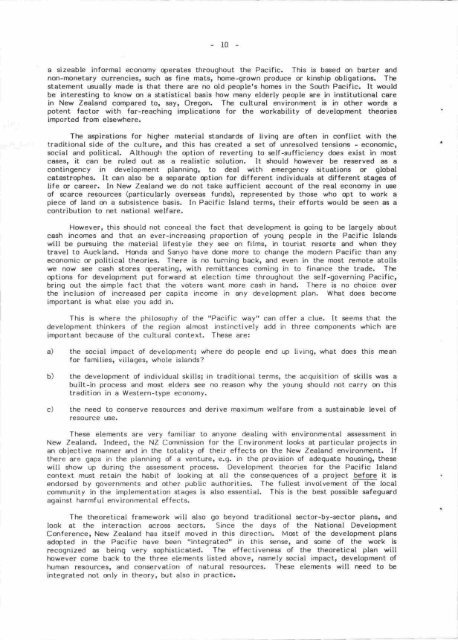Rt€@lll
Rt€@lll
Rt€@lll
You also want an ePaper? Increase the reach of your titles
YUMPU automatically turns print PDFs into web optimized ePapers that Google loves.
-10<br />
a sizeable informal economy operates throughout the Pacific. This is based on barter and<br />
non-rnonetary currencies, s.rch as fine mats, home-grown produce or kinship obligations. The<br />
statement usually made is that there are no old people's homes in the South Pacific. It would<br />
be interesting to know m a statistical basis how many elderly people are in institutional care<br />
in New Zealand compared to, say, Oregon. The cultural environnent is in other worde a<br />
potent factor with far-reaching implications for the workability of developnent theories<br />
imported from elsewhere.<br />
The aspirations for higher material standards of living are often in conflict with the<br />
traditional side of the culture, and this has created a set of unresolved tensiong - economic,<br />
social and political. Although the option of reverting to self-sufficiency does exist in most<br />
cases, ii can be ruled out as a realistic solution. It should however be reserved as a<br />
contingency in development planning, to deal with emergency situations or global<br />
catastrophes. It can also be a separate qlion for different individuals at different stages of<br />
life or career. In New Zealand we do not take zufficient accounl of the real economy in use<br />
of scarce resources (particularly overseas funds), represented by those who opt to work a<br />
piece of land m a subsistence basis. In Pacific Island terms, their efforts would be seen as a<br />
contribution to net national welfare.<br />
However, this should not conceal the fact that development is going to be largely about<br />
cash incomes and that an ever-increasing proportion of young people in the Pacific Islands<br />
will be pursuing the material lifestyle they see on films, in tourist resorts and when they<br />
travel to Auckland. Hmda and Sanyo have done more to chanqe Lhe modern Pacific than any<br />
economic or political lheories. There is no turning back, and even in the mos! remote atolls<br />
we now see cash stones operating, with remittances coming in to finance the trade. The<br />
options for development put forward at election time throughout the self-governing Pacific,<br />
bring out the simple fact that the voters wanL more cash in hand. There is no choice over<br />
the inclusion of increased per capita income in any development plan. What does become<br />
impontant is what else you add in.<br />
This is where the philosophy of the "Pacific way" ean offer a clue. It seems that the<br />
development thinkers of the region almost instinctively add in three components which are<br />
impontant because of Lhe cultural conLext, These are:<br />
a) the social impact of developmeni; where do people end up living, what does this rnean<br />
for families, villages, whole islands?<br />
b) the development of individual skills; in Lraditional lerms, the acquisition of skills was a<br />
built-in process and most elders see no reason why the young should not carry on this<br />
tradition in a Western-type economy.<br />
c) the need t.o conserve resources and derive maximum welfare from a zustainable level of<br />
nesource use.<br />
These elements are very familiar to anyone dealing with environrnental assessmenl in<br />
New Zealand. Indeed, the NZ Commission fon the f nvironment looks at particular projects in<br />
an objective manner and in the totality of their effects on the New Zealand environnrent. If<br />
there ane gaps in the planning of a venture, e.g. in the provision of adequate housing, these<br />
will show up during the assessment process. Development theories for the Pacific Island<br />
context must retain the habit of looking at all the consequences of a project before it is<br />
endorsed by governments and other public authorities. The fullest involvement oTfFE local<br />
communily in the implementation staqes is also essenLial. This is the best possible safeguard<br />
against harmf ul environmental effects.<br />
The theoretical framework will also go beyond Lraditional sector-by-sector plans, and<br />
look aL the interacLion across sectors. Since the days of the National Development<br />
Conference, New Zealand has itself moved in this direction. Mmt of the development plans<br />
adopted in the Pacific have been "integrated" in this sense, and some of the work is<br />
recognized as being very sophis[icated. The effectiveness of the theoreticel plan will<br />
however come back to the three elements listed above, namely social impact, development of<br />
human resources, and consenvation of natural resources. These elements will need to be<br />
integrated not only in theory, but also in pnactice.














![R]€@lll](https://img.yumpu.com/7594335/1/175x260/reurlll.jpg?quality=85)
